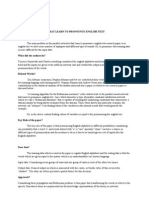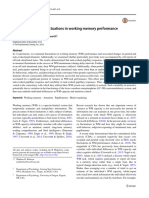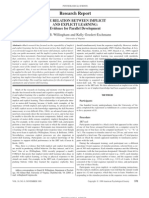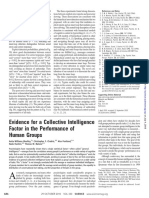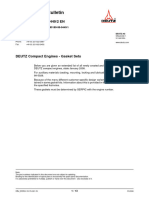Mazes Task
Mazes Task
Uploaded by
Anett SzabóCopyright:
Available Formats
Mazes Task
Mazes Task
Uploaded by
Anett SzabóCopyright
Available Formats
Share this document
Did you find this document useful?
Is this content inappropriate?
Copyright:
Available Formats
Mazes Task
Mazes Task
Uploaded by
Anett SzabóCopyright:
Available Formats
Mazes task – Lab report
Szabó Anett Zsuzsanna (EEMRDO)
Introduction
The Mazes task is a commonly used task to collect more information about learning and
working memory in the field of psychology. Researchers typically prefer to use rodents
(rats or mice) in these studies from the beginning (Small, 1901). Since then, several
types of mazes have been invented, for instance, the T-maze (Tolman, 1925) and the
Radial Arm Maze (Olton & Samuelson, 1976).
Exposure to acute stress can be an important factor in the efficiency of learning.
Depending on the brain system involved in storing and retrieving the information
(hippocampal vs. nonhippocampal memory systems) and the level of difficulty of the
task, stress can modify the number of errors made in experimental conditions (Diamond
et al., 1999).
The usage of the Mazes task on human participants is less common. Despite that it can
be shown that participants were slower to respond after stress in a virtual reality
pointing-to-target task, suggesting interference in the ability to adopt new spatial
orientations (Richardson & VanderKaay Tomasulo, 2011).
We expect that cognitively healthy participants will perform good on the task, and it will
require less time each trial to escape the maze as participants learn the correct rout. We
also expect that the number of errors will decrease at the end compared to the
beginning.
Methods
Participants. The task was administered on 17 participants (16 females and one male)
from the population of Ba psychology students at Eötvös Loránd University.
Materials and Procedure. We used the American Psychological Association’s online
psychology laboratory Mazes test.
In the task, participants were presented with 15 trials of the maze. In each trial, the
participants can see an image of three walls, which might have doorways on them. are
asked to move through them to the following room until the participants can escape the
maze. Below the image of the passageway are four arrows corresponding to the four
different directions: forward, backward, left, and right. Participants need to click on the
arrow that represents the direction they wish to move. On every instance they turn onto
an incorrect path it is counted as an error. Trial time is measured from the first time the
passageway appears until the moment of escaping from the last room. After each trial a
massage appears showing the time required to complete the round.
There was no practice phase or break during the task.
Results
We observed a decreasing trend in both number of errors (Figure 1.) and trial time
(Figure 2.). Due to this decreasing trend, a functional connection was tried to be
established to both data. According to the trend, a decreasing linear function was fitted
and visualized between the number of trials and the averaged number of errors
(Figure 1), which showed a considerable deviation from this fitted function.
Figure 1. The average number of errors decreases as the participants
complete the trials. Contrary to the decreasing trend, no unequivocal linear
connection can be observed between the number of trials and averaged number of errors
due to the considerable error of the linear function fitting ( 20%).
In case of the average escape time decreasing exponential function was fitted to the data.
In the first three trials there are huge differences between the required time to complete
the turn of the task. However, from the fourth trial the values did not differ as
considerably as before. Therefore, a decreasing exponential function can be fitted to the
data.
Figure 2. The average escape time decreases as the participants complete
the trials. The decaying exponential function can be fitted to the data showing the
decreasing nature of the average escape time as a function of the number of trials.
Discussion
The results are in line with our expectations. As the number of trials increase the
required time to complete the task decreases. It can be explained by that the
participants learned from their mistakes as well as they memorized the correct path.
One of the limitations is that our database contained only results of one male so no
conclusion can be derived for the differences among sexes in this setting. Furthermore,
it can be a possibility that the participants did not truly learn the pathways and they
rather learned the correct sequence of the arrows.
References
Diamond, D. M., Park, C. R., Heman, K. L., & Rose, G. M. (1999). Exposing rats to a
predator impairs spatial working memory in the radial arm water maze.
Hippocampus, 9(5), 542–552. https://doi.org/10.1002/(SICI)1098-
1063(1999)9:5<542::AID-HIPO8>3.0.CO;2-N
Olton, D. S., & Samuelson, R. J. (1976). Remembrance of places passed: Spatial memory
in rats. Journal of Experimental Psychology: Animal Behavior Processes, 2(2),
97–116. https://doi.org/10.1037/0097-7403.2.2.97
Richardson, A. E., & VanderKaay Tomasulo, M. M. (2011). Influence of acute stress on
spatial tasks in humans. Physiology & Behavior, 103(5), 459–466.
https://doi.org/10.1016/j.physbeh.2011.03.019
Small, W. S. (1901). Experimental Study of the Mental Processes of the Rat. II. The
American Journal of Psychology, 12(2), 206–239.
https://doi.org/10.2307/1412534
Tolman, E. C. (1925). Purpose and cognition: The determiners of animal learning.
Psychological Review, 32(4), 285–297. https://doi.org/10.1037/h0072784
GUIDELINES
1. A bevezetőben jelenjen meg legalább 2 cikk az eredeti publikált teszten felül, és
vezessétek be tágabban is a felmért jelenséget!
2. Ha rövidítést használtok, mindig írjátok ki először a szövegben, aztán zárójelben a
rövidítést, és utána használhatjátok röviden.
3. Ha a tesztnek ismert az eredeti szerzője, akkor rá hivatkozni kell, ha pedig valakitől
adaptáljátok, akkor ő rá.
4. Angolul "et al.", magyarul "és mtsai."
5. Mindig írjátok le röviden, hogy mire számítotok!
6. Kell a résztvevők neme, életkori eloszlása, valamint a populáció ahonnan a minta
származik.
7. Mindent le kell írni pontosan, hogy reprodukálható legyen akárki számára.
8. A procedúra pontos menete, időben.
9. A megjelenő ingerek részletes ismertetése
10. A procedúra összes próbájának száma és az esetleges közbeiktatott dolgok.
11. Mindig hivatkozzatok rá, hogy a feladat mely implementációját végeztétek el (ha a
weboldal megad hivatkozást, azt kell hivatkozni; ha nem, elég maga a weboldal APA-
stílusban)
12. 1-től 10-ig a számokat betűvel írjuk ki: one, two, three, stb… 10 felett számmal: 11,12,13
13. Az ábrán mindig legyen cím, tengely megnevezés, az oszlopok elnevezése és a
felosztások megjelenítése
14. Hivatkozni kell az ábrára, amit készítesz az ábra számával.
15. Az ábra alá mindig rakunk egy leírást, amiben egy kicsivel részletesebben leírjuk az
ábrán látottakat. Ezt a leírást mindig számozással vezetjük be („1. ábra” itt), és erre
hivatkozunk a szövegben. Továbbá az első mondat az ábra leírásban mindig egy címnek
felel meg.
16. Foglald össze, hogy mit mutat az eredmény, és ez összhangban áll-e azzal, amire
számítottál. Próbálj meg következtetni, hogy ez mit jelenthet!
17. Írj limitációkat, amik miatt a teszt felvétel nem volt tökéletes, és ítj javaslatot is, ami
specifikus az adott tesztre.
18. A hivatkozások mindig APA-formátumban és ABC-sorrendben kell legyenek.
19. A Zotero ezt pl. automatikusan megcsinálja.
20. Minden hivatkozás, amit ide beillesztesz, meg kell jelenjen a szövegben is! Illetve vica-
versa, minden, ami megjelenik a szövegben, itt is fel kell legyen tüntetve.
You might also like
- Tower of London ManualDocument100 pagesTower of London ManualLucyRainNo ratings yet
- Stances & Motions For Cheerleading: Includes Step-By-Step Visuals!Document36 pagesStances & Motions For Cheerleading: Includes Step-By-Step Visuals!regine romeroNo ratings yet
- Revised Wheres WaldoDocument5 pagesRevised Wheres Waldoapi-284026302No ratings yet
- Miller S Magic Number 7 and More...Document2 pagesMiller S Magic Number 7 and More...Jacky Lee100% (1)
- 2.10 Displacement Theory of ForgettingDocument2 pages2.10 Displacement Theory of Forgettingprincessaay99No ratings yet
- Topic: Parallel Networks That Learn To Pronounce English Text ProblemDocument7 pagesTopic: Parallel Networks That Learn To Pronounce English Text ProblemGowtham Kumar100% (1)
- Chemistry LO1 (SSC)Document11 pagesChemistry LO1 (SSC)bekobaka2No ratings yet
- tmpEAA5 TMPDocument8 pagestmpEAA5 TMPFrontiersNo ratings yet
- Mentális ForgatásDocument3 pagesMentális ForgatásAnett SzabóNo ratings yet
- Exploring The Stroop EffectDocument9 pagesExploring The Stroop EffectKaren MarquezNo ratings yet
- NYA Lab 2B Scientific Method Statistics W2022Document13 pagesNYA Lab 2B Scientific Method Statistics W2022Ilyes JebaliaNo ratings yet
- Chaos Theory and The Evolution of Traffic LawDocument24 pagesChaos Theory and The Evolution of Traffic LawMahdiNo ratings yet
- Loftus and Palmer 1974 Experiment ReplicaDocument13 pagesLoftus and Palmer 1974 Experiment ReplicaTyler RaveNo ratings yet
- 15 Puzzle ProblemDocument17 pages15 Puzzle ProblemPranoveNo ratings yet
- BIOL2310 Prac 6 Arthropod DiversityDocument5 pagesBIOL2310 Prac 6 Arthropod Diversityrowanhowes1No ratings yet
- Lab4 Experiments Key Answer KeyDocument4 pagesLab4 Experiments Key Answer KeymattNo ratings yet
- Urinal PDFDocument12 pagesUrinal PDFRITANSHI KUMARNo ratings yet
- BackgroundDocument2 pagesBackgroundKaruna JohnsonNo ratings yet
- Sidman 1987Document8 pagesSidman 1987siepaNo ratings yet
- Short-Essay QuestionsDocument6 pagesShort-Essay QuestionsWinnie NgNo ratings yet
- 9.1 Memories As Types and Stages - Introduction To Psychology - 1st Canadian EditionDocument11 pages9.1 Memories As Types and Stages - Introduction To Psychology - 1st Canadian EditionKhushi MalhotraNo ratings yet
- Statistics ResponsesDocument4 pagesStatistics ResponsesDenis McdenohNo ratings yet
- Three Times and Were Alright ReplicatesDocument5 pagesThree Times and Were Alright ReplicatesOmar FaruqNo ratings yet
- Faculty of Science and Mathematics Biology Department SBI3013 Information and Communication Technology in BiologyDocument9 pagesFaculty of Science and Mathematics Biology Department SBI3013 Information and Communication Technology in BiologyNadia AliasNo ratings yet
- Pupillometry Tracks Fluctuations in Working Memory PerformanceDocument13 pagesPupillometry Tracks Fluctuations in Working Memory Performancesirenhu8No ratings yet
- TMP 1892Document21 pagesTMP 1892nithiananthiNo ratings yet
- Cognition: Virginie Crollen, Marie-Pascale Noël, Xavier Seron, Pierre Mahau, Franco Lepore, Olivier CollignonDocument6 pagesCognition: Virginie Crollen, Marie-Pascale Noël, Xavier Seron, Pierre Mahau, Franco Lepore, Olivier CollignonSarghuna RaoNo ratings yet
- m246 1 Chapter06Document41 pagesm246 1 Chapter06Maandy PhamNo ratings yet
- Dela Cruz Jayrell222Document10 pagesDela Cruz Jayrell222api-26570979No ratings yet
- Pupil Diameter and Load On MemoryDocument4 pagesPupil Diameter and Load On MemoryieysimurraNo ratings yet
- STELLADocument10 pagesSTELLAAfiqah IekaNo ratings yet
- Willingham - Relation Between Implicit and Explicit LearningDocument4 pagesWillingham - Relation Between Implicit and Explicit LearningMakaNo ratings yet
- Evidence For A Collective Intelligence Factor in The Performance of Human GroupsDocument4 pagesEvidence For A Collective Intelligence Factor in The Performance of Human GroupspsiserviciosprofeNo ratings yet
- Probability, Statistics, and Reality: Essay Concerning The Social Dimension of ScienceDocument10 pagesProbability, Statistics, and Reality: Essay Concerning The Social Dimension of Scienceforscribd1981No ratings yet
- ArticleQuadrilaterals PsyarxivDocument24 pagesArticleQuadrilaterals PsyarxivJoseline VegaNo ratings yet
- Phil Brief Research ExplanationDocument3 pagesPhil Brief Research ExplanationBintang RidhoNo ratings yet
- Statistics in DetailsDocument283 pagesStatistics in Detailsyousef shaban100% (2)
- Lab 1 1Document8 pagesLab 1 1api-524551643No ratings yet
- Calculating The Decision TimesDocument9 pagesCalculating The Decision TimesSubashini BakthavatchalamNo ratings yet
- Pte SpeakingDocument185 pagesPte SpeakingAlva KlinNo ratings yet
- IB Psychology Sample Paper 1 With Answers PDocument2 pagesIB Psychology Sample Paper 1 With Answers PRudra RathodNo ratings yet
- Cerebral Activation Related To Implicit Sequence Learning in A Double Serial Reaction Time TaskDocument12 pagesCerebral Activation Related To Implicit Sequence Learning in A Double Serial Reaction Time TaskmfhfhfNo ratings yet
- SR20712235525Document5 pagesSR20712235525Herciu Renata MoisaNo ratings yet
- Global Matching Models of Recognition Memory How The Models Match The DataDocument24 pagesGlobal Matching Models of Recognition Memory How The Models Match The DatafutulashNo ratings yet
- Predictors of Multitasking Performance in A Synthetic Work ParadigmDocument19 pagesPredictors of Multitasking Performance in A Synthetic Work ParadigmThiago RiveroNo ratings yet
- Lab1: Scientific Method: Biology 6A/ Bruce Heyer & Brian Mccauley September 24 & 25, 2007Document10 pagesLab1: Scientific Method: Biology 6A/ Bruce Heyer & Brian Mccauley September 24 & 25, 2007Ku Nurul Afiqah50% (2)
- Plasicity PaperDocument4 pagesPlasicity Paperapi-310809886No ratings yet
- Intro To ExperimentDocument16 pagesIntro To ExperimentYean MarquezNo ratings yet
- Serial MemoryDocument24 pagesSerial Memorygnana.parsuNo ratings yet
- CL ThesisDocument4 pagesCL Thesistiffanycarpenterbillings100% (2)
- Introduction To Survival Analysis With Stata SeminarDocument16 pagesIntroduction To Survival Analysis With Stata Seminarhubik38No ratings yet
- Crouzet 2010Document17 pagesCrouzet 2010ricardo.silvaNo ratings yet
- FCM2063 - Printed NotesDocument126 pagesFCM2063 - Printed NotesRenuga SubramaniamNo ratings yet
- Collective Intelligence ScienceDocument3 pagesCollective Intelligence SciencePaulo CarvalhoNo ratings yet
- Wolfe, Cave-Guided Search. An Alternative To The Feature Integration Model of Visual SearchDocument15 pagesWolfe, Cave-Guided Search. An Alternative To The Feature Integration Model of Visual SearchMagali La RoccaNo ratings yet
- Probability and StatisticDocument132 pagesProbability and Statisticjychong100% (1)
- Encyclopedia of StatisticsDocument143 pagesEncyclopedia of Statisticsbedanta87100% (1)
- Probability and Statistics For Engineers and Scientist1Document10 pagesProbability and Statistics For Engineers and Scientist1AssagNo ratings yet
- Inversion TheoryDocument11 pagesInversion TheoryZulfian FiskNo ratings yet
- Stationary and Related Stochastic Processes: Sample Function Properties and Their ApplicationsFrom EverandStationary and Related Stochastic Processes: Sample Function Properties and Their ApplicationsRating: 4 out of 5 stars4/5 (2)
- Science PMRDocument72 pagesScience PMRJiaYing WinNo ratings yet
- Regulador Pilotado Mod. GP2000Document2 pagesRegulador Pilotado Mod. GP2000vanguevNo ratings yet
- Gasket Set Compact Engines 2Document13 pagesGasket Set Compact Engines 2ibrahim salemNo ratings yet
- Nori and LeetsDocument1 pageNori and LeetspbarsingNo ratings yet
- Worksheet A: Equences and EriesDocument2 pagesWorksheet A: Equences and EriesMihai CatanaNo ratings yet
- Study Materials: Vedantu Innovations Pvt. Ltd. Score High With A Personal Teacher, Learn LIVE Online!Document21 pagesStudy Materials: Vedantu Innovations Pvt. Ltd. Score High With A Personal Teacher, Learn LIVE Online!Sumit PatelNo ratings yet
- 01 Chemical ProcessDocument333 pages01 Chemical ProcessDavid ValladaresNo ratings yet
- Paint System - BERGER RecommendationsDocument1 pagePaint System - BERGER Recommendationsadarsh0% (1)
- Instrucciones de Armado Torres Marlyn EtoDocument698 pagesInstrucciones de Armado Torres Marlyn EtoMarcoNo ratings yet
- PhysicalSci12 Q1 Mod1 Week2 Polarity of Molecules v3Document38 pagesPhysicalSci12 Q1 Mod1 Week2 Polarity of Molecules v3Corazon ReymarNo ratings yet
- 2Document14 pages2nadipallsrirajNo ratings yet
- Amc10 2000Document4 pagesAmc10 2000darrenn.cpNo ratings yet
- POGIL - Gene - Expression Translation SDocument8 pagesPOGIL - Gene - Expression Translation Sandrew fortneyNo ratings yet
- Hydropower Engineering I-6812 (3) PPTDocument64 pagesHydropower Engineering I-6812 (3) PPTArus Edo83% (6)
- Trip Generation (Cont.)Document30 pagesTrip Generation (Cont.)Phambra FiverNo ratings yet
- RICE 2017 Entries ListDocument8 pagesRICE 2017 Entries ListVal BasilNo ratings yet
- Fading Suns - Star ShipsDocument16 pagesFading Suns - Star ShipsJohn ChurchillNo ratings yet
- Pneumatic Ship Unloader PDFDocument12 pagesPneumatic Ship Unloader PDFSosten MagwevaNo ratings yet
- 435-450watt: 144 Cell Half Cut Mono Perc Solar ModuleDocument2 pages435-450watt: 144 Cell Half Cut Mono Perc Solar ModuleGandharv Kumar ThakurNo ratings yet
- Care (Health Insurance Product) Prospectus Cum Sales Literature NewDocument52 pagesCare (Health Insurance Product) Prospectus Cum Sales Literature NewGoutam HotaNo ratings yet
- AOC Judging Paphiopedilum 2017Document17 pagesAOC Judging Paphiopedilum 2017Mick TalbotNo ratings yet
- The Care of Congenital Myopathy: A Guide For Families. CMFG-2018-9-29 Update (Web Quality)Document105 pagesThe Care of Congenital Myopathy: A Guide For Families. CMFG-2018-9-29 Update (Web Quality)congenitalmyopathyresourceNo ratings yet
- 2016 ASME A Proposal To Consider Cycle Counting Methods For Fatigue Analysis of Nuclear and Conventional Power Plant ComponentsDocument10 pages2016 ASME A Proposal To Consider Cycle Counting Methods For Fatigue Analysis of Nuclear and Conventional Power Plant ComponentsGwanyun JeongNo ratings yet
- The Components of The System UnitDocument15 pagesThe Components of The System UnitGreg AlvarezNo ratings yet
- Dairy Farm 25 AnimalDocument38 pagesDairy Farm 25 Animalpradip_kumar67% (3)
- Delm 214 Curriculum, Instruction and AssessmentDocument12 pagesDelm 214 Curriculum, Instruction and AssessmentEdz SoretsellaBNo ratings yet
- Learning Activity Worksheet Science 9 Q1 Weeks 1 2Document7 pagesLearning Activity Worksheet Science 9 Q1 Weeks 1 2ar0411No ratings yet
- Propellers & Rotors Notes V2Document11 pagesPropellers & Rotors Notes V2Tara PillayNo ratings yet
- Reso-Net Sample Test Paper: For Students Moving in Class-X (Winner) in 2019-20Document8 pagesReso-Net Sample Test Paper: For Students Moving in Class-X (Winner) in 2019-20Manas SinghNo ratings yet





